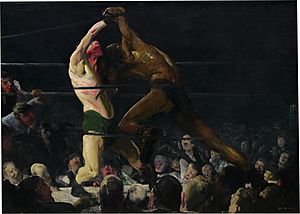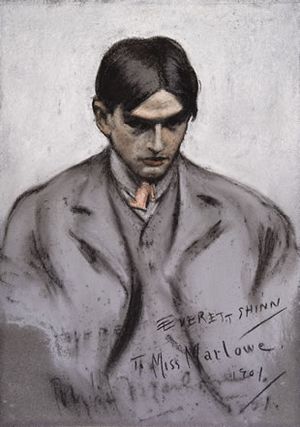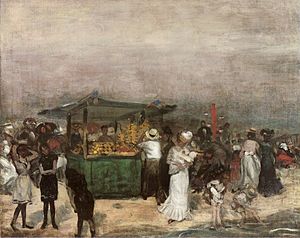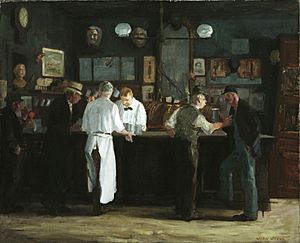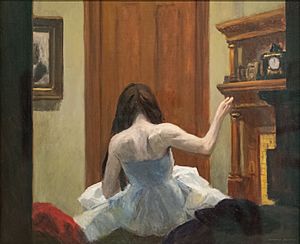American Realism facts for kids

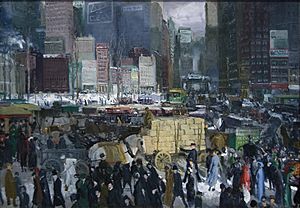
American Realism was a style in art, music, and writing that showed real life and the everyday activities of ordinary people. This movement started in writing in the mid-1800s. It became very important in visual art in the early 1900s. Whether showing a cultural scene or a view of New York City, American Realist works tried to show what was truly real.
In the U.S. at the start of the 20th century, new artists, writers, and journalists were becoming popular. Many painters were inspired by older American artists like Thomas Eakins and Winslow Homer. However, they wanted to create new works that showed city life. They focused on how America was becoming more urban than rural.
Contents
America in the Early 1900s
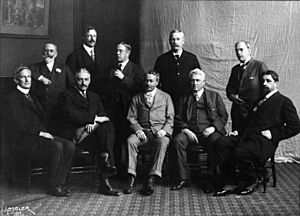
From the late 1800s to the early 1900s, the United States changed a lot. There was huge growth in industries, the economy, and culture. Many people immigrated from Europe, and international trade grew. This brought more prosperity to America.
Through art, writing, and music, American Realism tried to show the busy and exciting life of ordinary Americans. Artists used the feelings, textures, and sounds of the city in their paintings. Musicians noticed the fast pace of the early 20th century. They responded with new, quick tempos. Writers told new stories about Americans that felt real and relatable.
Moving away from fantasy, American Realism focused on "the now." It opened a new door for modern art and what it means to live in the present. The Ashcan School, also known as The Eight, and the group called Ten American Painters were key to this new American modernism in visual arts.
Ashcan School and The Eight
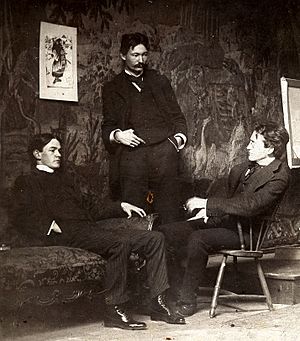
The Ashcan School was a group of artists in New York City. They wanted to capture the feeling of early 20th-century New York. They did this by painting realistic pictures of everyday life. These artists preferred to show the lives of working-class immigrants. They did not focus on rich socialites. Some critics did not like their choice of subjects. These included alleys, crowded buildings, and working-class taverns. Critics sometimes called them "the revolutionary black gang" or "apostles of ugliness."
George Bellows
George Bellows (1882–1925) painted city life in New York. His paintings were bold and daring. He was fascinated by action, as seen in his 1909 painting, Both Members of This Club. This work shows an intense boxing match. His 1913 painting Cliff Dwellers shows a city scene. It is not one specific view but a mix of many different city sights.
Robert Henri
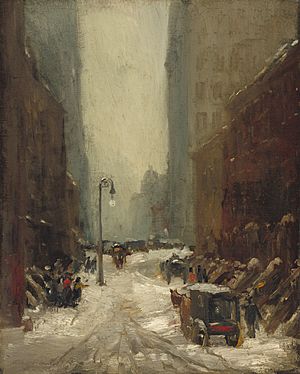
Robert Henri (1865–1921) was an important American Realist and a member of The Ashcan School. Henri was interested in the everyday scenes of common life. He focused on individuals, strangers passing quickly in city streets. He showed people in a kind way, often using a dark background to make the person seem warmer. Henri's works used strong brushstrokes and thick paint. This showed the texture of the paint itself. Henri influenced other artists like Glackens, Luks, Shinn, and Sloan.
Everett Shinn
Everett Shinn (1876–1953) was a member of the Ashcan School. He was known for his many paintings of New York and the theater. He also painted scenes of luxury and modern life in New York City. He painted theater scenes from London, Paris, and New York. He found interest in the exciting city life, seeing links between the theater and crowded places. Unlike Edgar Degas, Shinn showed interaction between the audience and the performers.
George Benjamin Luks

George B. Luks (1866–1933) was an Ashcan School artist who lived on the Lower East Side of Manhattan. In Luks' painting, Hester Street (1905), he shows children playing while adults talk in the background. The viewer feels like they are part of the crowd. Luks showed the positive side of the Lower East Side. For example, in The Spielers, he shows two young girls dancing. This was a type of dance working-class immigrants did. Despite poverty, children danced in the street. He looked for joy and beauty in the lives of the poor, not just sadness.
William Glackens
Early in his career, William Glackens (1870–1938) painted the area around his studio in Washington Square Park. He was also a successful illustrator. He made many drawings and watercolors for magazines. These humorously showed New Yorkers in their daily lives. Later, he became known as "the American Renoir." This was because of his Impressionist paintings of the seashore and the French Riviera.
John Sloan
John Sloan (1871–1951) was an early 20th-century Realist from the Ashcan School. He cared about American social conditions. He joined the Socialist Party in 1910. He moved from Philadelphia to New York in 1904. From 1912 to 1916, he drew for the socialist magazine The Masses. Sloan did not like propaganda. In his drawings and paintings, he focused on people's everyday lives. He showed working-class people enjoying their free time, often focusing on women. He disliked the "Ashcan School" name. He also didn't like being called a painter of the "American Scene." He felt it was too nationalistic.
Edward Hopper
Edward Hopper (1882–1967) was a well-known American realist painter and printmaker. Hopper is seen as one of the most modern American realists. While famous for his oil paintings, he was also skilled at watercolors and etching. In both his city and country scenes, his careful paintings showed his personal view of modern American life.
Hopper's teacher, Robert Henri, told his students to use art to "make a stir in the world." He also advised them, "It isn’t the subject that counts but what you feel about it" and "Forget about art and paint pictures of what interests you in life." Henri influenced Hopper, George Bellows, and Rockwell Kent. He encouraged them to paint realistic scenes of city life.
Other Visual Artists
Some other visual artists of this time included Joseph Stella, Charles Sheeler, Jonas Lie, Edward Willis Redfield, Joseph Pennell, Leon Kroll, B.J.O. Nordfeldt, Gertrude Käsebier, Alfred Stieglitz, Edward Steichen, E. J. Bellocq, and Philip Koch.
Writers
Horatio Alger, Jr.
Horatio Alger, Jr. (1832-1899) was a very active American writer in the 1800s. He wrote many popular "rags-to-riches" stories for young people. These stories followed poor children, like shoe shiners or newsboys. They would rise from humble beginnings to a comfortable middle-class life. His novels, like Ragged Dick, were very popular.
Stephen Crane
Stephen Crane (1871–1900) was born in Newark, New Jersey. He came from a family with roots back to the American Revolutionary War. Crane was mainly a journalist, but he also wrote stories, essays, poems, and plays. He saw life at its most raw, in poor neighborhoods and on battlefields. His powerful Civil War novel, The Red Badge of Courage, was published in 1895 and received great praise. He died at 28, having neglected his health. Crane is still known as a champion of the common person and a realist. Crane's Maggie: A Girl of the Streets (1893) is one of the earliest and best American naturalist novels.
William Dean Howells
William Dean Howells (1837–1920) wrote stories and essays in the realist style. His ideas about realism in writing grew along with his socialist views. As an editor for Atlantic Monthly and Harper's Magazine, and as an author of books like A Modern Instance, Howells had strong opinions. He was very influential in setting up his theories about realism.
Mark Twain
Samuel Clemens (1835–1910), better known as Mark Twain, grew up in Hannibal, Missouri, a town on the Mississippi River. Early 19th-century American writers often used fancy or overly emotional language. This was partly because they wanted to show they could write as elegantly as English writers. Ernest Hemingway said that all American fiction comes from Mark Twain's novel The Adventures of Huckleberry Finn.
Twain's writing style was based on strong, realistic, everyday American speech. This gave American writers a new appreciation for their own national voice. Twain was the first major author from the middle of the country. He captured its unique, funny slang and rebellious spirit. For Twain and other American writers of the late 1800s, realism was more than just a writing style. It was a way to speak the truth and break old rules. Twain is best known for his works Tom Sawyer and The Adventures of Huckleberry Finn.
Sam. R. Watkins
Sam. R. Watkins (1839–1901) was a 19th-century American writer and humorist. He is best known for his memoir, "Co. Aytch," which tells about his life as a soldier in the Confederate States Army. He was a great storyteller. One good quality of his book is its realism. In a time when people often made "the war" seem romantic, he wrote with surprising honesty. The soldiers in his book are not all heroes. Soldier life, as Watkins showed it, had more dullness and suffering than excitement or glory. He wrote about the crushing tiredness of long marches. He also described the boredom of long winter breaks, harsh discipline, and officers who were not always good. He told of uncertain and small food portions, and the tiring routine of army life. His battle stories often mention the terrible screaming of shells and the painful cries of the wounded. War, as he described it, was a cruel and messy business.
Others
Other writers of this style included Theodore Dreiser, Henry James, Jack London, Upton Sinclair, John Steinbeck, Margaret Deland, and Edith Wharton.
Journalism
Jacob Riis
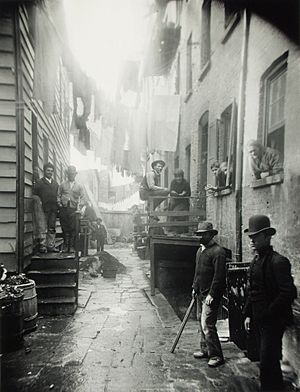
Jacob August Riis (1849–1914) was a Danish-American muckraker journalist, photographer, and social reformer. He was born in Ribe, Denmark. He was known for using his photography and writing skills to help poor people in New York City. This was the main topic of his many writings and photo essays. He helped create "model tenements" (apartment buildings) in New York with the help of humanitarian Lawrence Veiller. He was one of the first photographers to use flash, making him a pioneer in photography.
Art Young
Art Young (1866–1943) was an American cartoonist and writer. He is most famous for his socialist cartoons. These were especially for the magazine The Masses, where Young was a co-editor from 1911 to 1917. Young started as a generally non-political Republican. But he slowly became interested in left-wing ideas. By 1906, he considered himself a socialist. He became active in politics. By 1910, issues like racial and sexual discrimination and problems with the capitalist system became common themes in his work.
Music
James Allen Bland
James A. Bland (1854–1919) was the first well-known African American songwriter. He is known for his song, Carry me Back to Old Virginny. In the Evening by the Moonlight and Golden Slippers are also famous songs by him. He wrote other popular songs like In the Morning by the Bright Light and De Golden Wedding. Bland wrote most of his songs from 1879 to 1882. In 1881, he left America for England with a group called Haverly's Genuine Colored Minstrels. Bland found England more rewarding and stayed there until 1890.
C.A. White
C.A. White (1829–1892) wrote a hit song in 1869, Put Me in My Little Bed. This made him a major songwriter. White was a songwriter with serious goals. Many of his songs were written for vocal quartets. He also tried to write several operas. He co-owned the music publishing company White, Smith & Company. This gave him a way to release his work. But it was his songs that supported the publishing company. White also wrote for popular stage shows. However, his main work was for people who sang at home.
W.C. Handy
W. C. Handy (1873–1958) was a blues composer and musician. He is often called the "Father of the Blues." Handy remains one of the most influential American songwriters. He was one of many musicians who played the unique American music called the blues. But he is credited with giving it its modern form. While Handy was not the first to publish blues music, he helped the blues grow from a little-known regional style to a major force in American music. Handy was an educated musician who used folk material in his compositions. He was careful to note where his ideas came from. His works often combined styles from different performers. He loved this folk music and added his own special touch to it.
Scott Joplin
Scott Joplin (around 1867/68–1917) was an African American musician and composer of ragtime music. He is still the best-known figure in ragtime. His music became very popular again in the 1970s. This was especially true for his most famous song, "The Entertainer." This song was the main theme in the 1973 film The Sting.
Images for kids
-
Alfred Stieglitz, Winter – Fifth Avenue, 1893, a photograph.
-
Edward Steichen, The Flatiron Building, 1904, a photograph.
-
Joseph Pennell, The Waldorf-Astoria, around 1904–1908, a drawing.
-
Edward Willis Redfield, Brooklyn Bridge at Night, 1909, an oil painting.
-
The Old Ships Draw to Home Again, 1920, by Jonas Lie, at the Brooklyn Museum.
See Also



